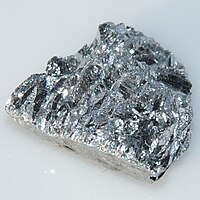
Photo from wikipedia
All-inorganic caesium lead halide perovskite nanocrystals (PeNCs) with different dimensionalities have recently fascinated the research community due to their extraordinary optoelectronic properties including tunable bandgaps over the entire visible spectral… Click to show full abstract
All-inorganic caesium lead halide perovskite nanocrystals (PeNCs) with different dimensionalities have recently fascinated the research community due to their extraordinary optoelectronic properties including tunable bandgaps over the entire visible spectral region, high photoluminescence quantum yields (PLQYs) close to unity and narrow emission line widths down to 10-20 nm, making them particularly suitable as promising candidates for numerous applications ranging from light-emitting diodes (LEDs), solar cells to scintillators. Despite the considerable progress made in the past six years, the real-world applications of caesium lead halide PeNCs themselves especially in the category of CsPbX3 (X = Cl, Br and I) are still restricted by their labile crystal lattices and downgraded luminescence when exposed to ambient air conditions. Recent experimental and theoretical studies on cation doping have proven to be an effective way to significantly improve the physicochemical properties of cesium lead halide PeNCs, which would have profound implications for a range of applications. In this review, we provide a brief overview of the most recent advances in cation-doped all-inorganic caesium lead halide PeNCs, aimed at developing high-performance and long-term stable optoelectronic and photovoltaic devices, which covers areas from their fundamental considerations of cation doping, controlled synthesis methodology and novel physicochemical properties to the optoelectronic applications with an emphasis on perovskite-based LEDs and solar cells. And finally, some possible directions of future efforts toward this active research field are also proposed.
Journal Title: Nanoscale
Year Published: 2020
Link to full text (if available)
Share on Social Media: Sign Up to like & get
recommendations!